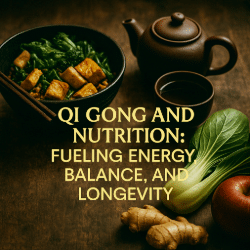Qi Gong and Nutrition: How Food Fuels Energy, Balance, and Longevity
Qi Gong and Nutrition – Explore how food and qi gong have been linked across history, cultures, and modern wellness to build lasting energy and balance.
Flagstaff, AZ USA

When people think of qi gong, they usually picture flowing movements, calm breathing, or perhaps monks in mountain robes practicing at dawn. What often gets left out of the conversation is food. But in every tradition I’ve studied and practiced, what you eat has always been considered part of the practice. Nutrition and qi gong are like two sides of the same coin: one builds and circulates energy, the other fuels and anchors it.
This article takes a wide-angle look at how qi gong and nutrition intersect—historically, geographically, and practically—so you can understand not just the “what,” but the “why.” From ancient Taoist dietary regimens to modern plant-based adaptations for athletes, we’ll cover the terrain and set the stage for deeper dives in future pieces.
Qi gong emerged from a blend of Taoist health practices, martial discipline, and medical observation. Diet was never far behind. Early medical texts like the Huangdi Neijing (Yellow Emperor’s Classic of Medicine) made clear that food was medicine before medicine was medicine. The Taoists in particular paid close attention to what nourished qi (life energy) and what blocked it.
Taoist Dietary Approaches: Early Taoist adepts experimented with fasting, grain avoidance (bigu), and herbal supplementation as ways to purify the body for meditation and energy work.
Confucian Influence: The Confucian ideal of balance extended to meals, emphasizing moderation and seasonal eating.
Buddhist Crossovers: In China and elsewhere, Buddhist vegetarianism shaped qi gong diets, especially for monastic practitioners.
Wherever qi gong developed, diet followed, adapted to local foods and climates.
Qi gong practice spread widely across East Asia, and each culture paired it with its own culinary backbone:
Northern China: Wheat, millet, and root vegetables provided grounding calories in cold climates. Practitioners leaned on warming broths and hearty porridges.
Southern China: Rice, leafy greens, and seafood influenced qi gong diets with lighter, water-rich foods.
Korea and Japan: Adaptations blended Taoist ideas with local staples like seaweed, soy, and fermented foods (kimchi, miso), supporting both digestion and qi circulation.
Southeast Asia: Tropical fruits, spices, and fish-based diets were integrated with qi practices, often in martial arts communities.
Geography shaped the palette, but the principle remained the same: align diet with environment to support energy flow.
Qi gong isn’t just about movement—it’s a healing art. And diet is one of its core prescriptions.
Five Elements Approach: Foods are categorized by flavor and energetic quality (sweet, sour, bitter, pungent, salty) and matched with organ systems.
Seasonal Eating: In Taoist and TCM-influenced qi gong, diet shifts with the seasons—lighter greens in spring, cooling fruits in summer, roots in autumn, warming stews in winter.
Digestive Qi: A strong emphasis is placed on the “middle burner” (spleen and stomach). If digestion is weak, qi cannot be strong. Hence the importance of warm, cooked foods and avoiding excess cold/raw foods in certain traditions.
The past gives us frameworks, but today’s practitioners face new challenges—processed food, sedentary work, and athletic demands. How does qi gong nutrition adapt?
For Athletes & Martial Artists: Protein-rich vegetarian options (tofu, tempeh, lentils, seeds) support recovery without overtaxing digestion.
For Stress & Longevity: Anti-inflammatory diets (greens, omega-3 sources, teas) align perfectly with qi gong’s restorative aims.
For Everyday Wellness: Balancing macronutrients while following seasonal patterns provides both practicality and tradition.
No matter the culture, three principles show up again and again in qi gong-related nutrition:
Moderation – Overeating dulls qi.
Alignment with Nature – Seasonal, local, fresh foods.
Digestive Care – Strengthening the stomach and spleen energy.
Qi gong is about cultivating vitality, resilience, and clarity of mind. Nutrition is about fueling those same goals. When you put the two together, you’re not just eating or exercising—you’re practicing a full system of health that has been evolving for thousands of years.
For martial artists, athletes, and anyone looking to bring more energy into their day, the lesson is simple: move with purpose, eat with awareness, and watch how your life force grows.
Food provides the raw materials your body uses to build and circulate qi. Balanced, minimally processed meals help digestion (“middle burner”) so breathwork and movement produce steadier energy and recovery.
No. Traditions emphasize moderation, seasonal foods, and digestive comfort. Adjust for your climate, activity level, and personal responses.
Before: a light, easily digested snack 60–90 minutes prior (e.g., fruit with nuts, congee, miso soup). After: a balanced meal with protein, complex carbs, and vegetables to refuel and support recovery.
Yes. Tofu, tempeh, lentils, beans, quinoa, nuts, and seeds can meet protein needs when total calories and variety are adequate.
Current evidence does not show clinically meaningful testosterone reductions from moderate soy intake in healthy adults. Focus on overall diet quality and training consistency.
Spring: greens and light dishes. Summer: hydrating foods and fruits. Autumn: roots and grains. Winter: warm stews and broths. Aligning food with climate supports energy balance.
These are historical practices with specific contexts. If explored, use short, supervised trials and avoid during intense training, pregnancy, illness, or disordered eating risk.
Gentle options like green tea, roasted oolong, ginger, or goji-jujube infusions can complement practice. Herbs can interact with medications—consult a qualified professional.
Favor warm, cooked meals; chew thoroughly; reduce ultra-processed foods and excess cold/raw items; adjust fiber gradually; track triggers; and time practice away from heavy meals.
This information is educational and not a substitute for personalized medical advice. Consult your clinician for conditions, medications, or specialized diets.